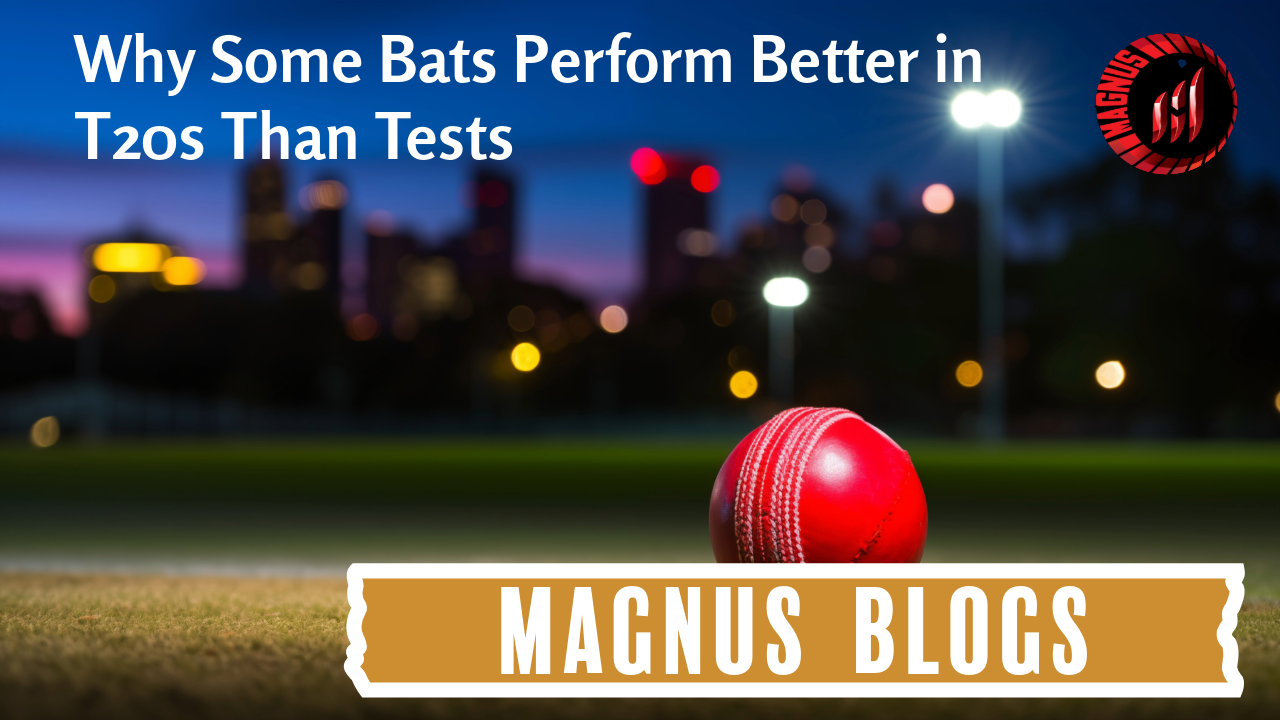When it comes to cricket bats, one size definitely doesn’t fit all—especially across formats like T20s and Test matches. The demands of each game are drastically different, and so are the bats players use to meet those demands. In this blog, we’ll explore why certain bats perform better in T20 cricket compared to Tests, and how you can choose the right one based on your format of play.
1. Format Demands: T20 vs. Test Cricket
Before we get into the bats, it’s important to understand the difference in how each format is played:
T20 cricket is fast-paced. Batsmen aim to score quickly, often clearing boundaries with powerful shots. The focus is on maximum impact in minimum time.
Test cricket is about patience and technique. Players may bat for hours, playing more defensively. Shot selection and timing outweigh brute power.
These core differences directly impact the kind of bat that works best for each format.
2. Bat Profile: Power vs. Precision
T20 bats often have thicker edges, lower or mid sweet spots, higher spines, and broader blades. They’re built for explosive hitting, especially over the infield and for big boundary shots. Many have a shorter blade and longer handle setup for better swing speed.
Test bats feature traditional profiles with more balanced weight distribution and slightly smaller edges. They’re designed for control, balance, and precision, ideal for front-foot and back-foot defense or fluent strokeplay.
3. Bat Weight: Heavy Hitters vs. Balanced Feel
In T20s, players often go for slightly heavier bats for maximum hitting power. A little more bat speed and edge thickness can turn mishits into boundaries.
In Tests, a lighter, well-balanced bat allows for long innings without causing fatigue. It also helps with quick foot movement and better shot adjustment in swinging or spinning conditions.
4. Sweet Spot Positioning
The sweet spot—the area of the bat where you get maximum power with minimal effort—is often optimized differently.
T20 bats have the sweet spot positioned lower or in the middle, because many shots are played off full-length balls and yorkers.
Test bats tend to have a higher sweet spot, more suitable for back-foot play, cuts, and defensive strokes.
5. Handle Type: Control vs. Power
Oval handles, more common in Test bats, offer better control and grip for long stints at the crease.
Round handles, preferred in T20 bats, allow for faster wrist rotation, helping in flicks and aggressive power shots.
6. Wood Compression and Bat Longevity
T20 players may prefer softer, highly compressed willow to get better ping off the bat, even if it means reduced longevity.
Test bats are usually made from slightly harder pressed willow for more durability, as they're used over extended innings.
7. Branding and Marketing Differences
Many bat manufacturers offer separate T20-specific models with aggressive styling, thick toe profiles, and bold aesthetics to match the energy of the format. Test bats often retain a more traditional design, with focus on grain quality and structure over visual appeal.
8. Choosing the Right Bat for You
Here’s a quick reference guide:
| Feature | T20 Bat | Test Bat |
|---|---|---|
| Sweet Spot | Mid to low | Mid to high |
| Edge Thickness | Thick | Medium |
| Bat Weight | Slightly heavier | Balanced |
| Handle Shape | Round | Oval |
| Balance | Bottom-heavy | Even/balanced |
| Power vs. Control | Power | Control |
If you’re playing both formats, consider having two separate bats in your kit—one built for quickfire runs, the other for technical, longer gameplay.
Cricket bat types, Cricket equipment in usa, Cricket equipment store, Cricket gloves, Cricket helmet, Cricket kit bags, Cricket retailers, Durable cricket gloves, English willow bats, Icc approved helmets., Kashmir willow cricket bat, Latest kashmir willow bat
